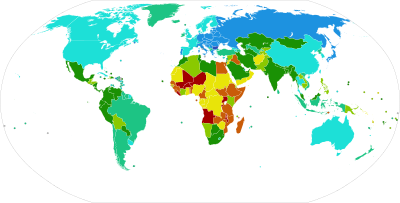What Is Rate Of Natural Increase

The natural increment in population, from the CIA World Factbook, 2022.
| ≥ 30 25 – 29.99 20 – 24.99 fifteen – 19.99 | 10 – 14.99 five – 9.99 0 – 4.99 -5 – -0.01 | < -5 Information unavailable |
In Census, the rate of natural increase (RNI), too known equally natural population modify, is defined equally the birth rate minus the expiry charge per unit of a particular population, over a particular time catamenia.[1] It is typically expressed either equally a number per 1,000 individuals in the population[2] or every bit a per centum.[3] RNI tin be either positive or negative. It contrasts to total population modify past ignoring net migration.
This RNI gives demographers an insight into how a region's population is evolving, and these analyses tin inform government attempts to shape RNI.
Examples [edit]
Suppose a population of five,000 individuals experiences 1,150 live births and 900 deaths over the class of ane year.
To show the RNI over that yr as a percentage, the equation would be
(1,150 – 900) ÷ 5,000 = 0.05 = +v%
To evidence the RNI every bit a number per i,000 individuals in the population, the equation would be
(ane,150 – 900) ÷ (5,000/1,000) = 250 ÷ 5 = +l
Information technology can also exist shown equally natural births per i,000 minus deaths per 1,000
(1,150 ÷ five) – (900 ÷ five) = 230 – 180 = +50
To convert the RNI per one,000 population to a percentage, divide information technology by 1,000. The equation would exist
+fifty ÷ 1,000 = 0.05 = +5%
Uses [edit]
The rate of natural increase gives demographers an idea of how a region's population is shifting over time. RNI excludes in-migration and out-migration, giving an indication of population growth based only on births and deaths. Comparison natural population change with total population change shows which is dominate for a particular region. Looking at this departure beyond regions reveals those that are changing mainly due to births exceeding deaths and those irresolute mainly due to migration. The map shows simply such an assay for the US.[1]

Most Influential Component of Alter for US Counties That Gained Population Between 2022 and 2022
The tendency of RNI over time tin can indicate what stage of the Demographic Transition Model (DTM) a region or country is in.
National efforts to impact RNI [edit]
Government attempts to shape the RNI of a region or country are common around the world.[4] Policies tin can either encourage or discourage an increase in nascency rates. For example, during the COVID-19 crisis Singapore offered families a "pandemic infant bonus" to encourage a higher birth rate, therefore increasing RNI.[v] The US has considered like policies.[6] Another example was People's republic of china'south one child policy, intended to decrease nascency rates, therefore decreasing the RNI.[7]
A country with a skillful infrastructure to support families, women's health, and maternal/child wellness would likely take lower decease rates from infant or maternal mortality, which would increase RNI.
Come across also [edit]
- List of countries by natural increase
- Birth rate
- Mortality charge per unit
- Population growth
References [edit]
- ^ a b Rogers, Luke; Borsella, Peter (March 24, 2022). "Growth or Decline: Understanding How Populations Change". U.s. Demography Bureau.
{{cite web}}: CS1 maint: url-condition (link) - ^ "World Population Prospects". United Nations Department of Economic and Social Diplomacy.
{{cite web}}: CS1 maint: url-status (link) - ^ "Estimates, 1950 - 2022: Annually interpolated demographic indicators - Rate of natural increase (per 1,000 population)". Our Earth In Information.
{{cite web}}: CS1 maint: url-status (link) - ^ "Government policies to raise or lower the fertility leve" (PDF). Population Facts, United Nations Department of Economics and Social Affairs. December 2022.
{{cite web}}: CS1 maint: url-condition (link) - ^ "Singapore offers 'pandemic baby bonus' to boost births". BBC News. October 6, 2022.
{{cite web}}: CS1 maint: url-condition (link) - ^ Cain Miller, Claire (February 17, 2022). "Would Americans Take More than Babies if the Authorities Paid Them?". New York Times.
{{cite web}}: CS1 maint: url-condition (link) - ^ Hesketh, Therese; Lu, Li; Xing, Zhu Wei (2005-09-fifteen). "The Effect of China'south One-Child Family Policy afterward 25 Years" (PDF). New England Periodical of Medicine. 353 (11): 1171–1176. doi:ten.1056/NEJMhpr051833. ISSN 0028-4793. PMID 16162890.
What Is Rate Of Natural Increase,
Source: https://en.wikipedia.org/wiki/Rate_of_natural_increase
Posted by: cooperevines1973.blogspot.com


0 Response to "What Is Rate Of Natural Increase"
Post a Comment